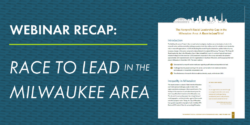Jul
17
2020
Written by Tessa Constantine (Research Analyst)
The Building Movement Project (BMP) recently hosted a webinar on the findings of the newly released brief, The Nonprofit Racial Leadership Gap in the Milwaukee Area: A Race to Lead Brief. This webinar also featured a panel discussion with Meralis Hood (Executive Director of City Year Milwaukee), Undraye Howard (Senior Director of Equity, Diversity, Inclusion and Engagement of the Alliance for Strong Families and Communities), and Ashley Lee (Executive Director of Public Allies Milwaukee).
Quick Access: Recording, Transcript, Slides
The conversation with the panelists, whose work is deeply rooted in and around the Milwaukee area, was engaging, thought provoking, and affirming. Some of the key takeaways are noted below.
The importance of mentors
Ashley kicked off the conversation by discussing the “imposter syndrome” that many people of color feel in white-dominant, nonprofit spaces. This experience is more than just a feeling, as the data shows staff and leaders of color experience negative impacts on their career advancement due to a lack of networks, mentorship opportunities, and other support systems to which their white counterparts have more access. Ashley noted that one of the main reasons she has been able to stay in this work is other women of color who have mentored, elevated and supported her own leadership. Meralis echoed this point, adding that mentors are a vital resource because they uplift people, provide support, and extend their networks. She noted that mentors “have been able to make the introductions, to pull up a seat at the table for me, to validate my leadership and lend credibility.”
On a related note, the diversification of boards and leadership is a way to embed mentors of color in positions of power in the sector. Specifically pointing to the value of board diversity, Undraye stated “we know that diverse boards can bring to the table different voices, perspectives, innovation, [and] lived experiences.” He reminded us that strength and capacity do not come from simply attaining a diverse board, but from retaining that board and providing the supports necessary to sustain its members. The panelists painted a powerful picture of the strength of organizations with diverse boards and leadership, particularly in the ways these leaders can become potential mentors to other people of color.
The funding landscape
Another highlight from the Milwaukee area brief was the role of grantmakers in pushing for greater diversity in the organizations they fund. Similar topics were also discussed by the panelists, who delved into the funding atmosphere in the region’s nonprofit sector and provided insights into how grants can be implemented to create greater change. One of the findings from the report was that local survey respondents had a lower average level of agreement that increased funding for organizations led by people of color would help increase nonprofit sector leadership diversity. Undraye highlighted that Milwaukee is a hyper-segregated city and that “if we are truly going to try to achieve advanced social change around the issue of race, then we need to invest in leaders who are Brown and Black, period.” Making a similar point about the need to get funding in the hands of leaders of color, Ashley pointed out the rise of mutual aid funding in the current moment and offered that “one of the most equitable ways to get resources directly into the hands of people is through mutual aid efforts.”
The panelists in our recent webinar provided critical insights and expertise that reaffirmed what we heard in the 2019 Race to Lead survey and focus groups in Milwaukee. We are so grateful to them for taking the time to share their wisdom on the local sector with us. These insights provide opportunities for growth and continued work around race equity in the sector.
To explore more of the data and analyses, you can download the full report. You can also watch the webinar recording below (or on YouTube), read the webinar transcript, and download the presentation slides.

